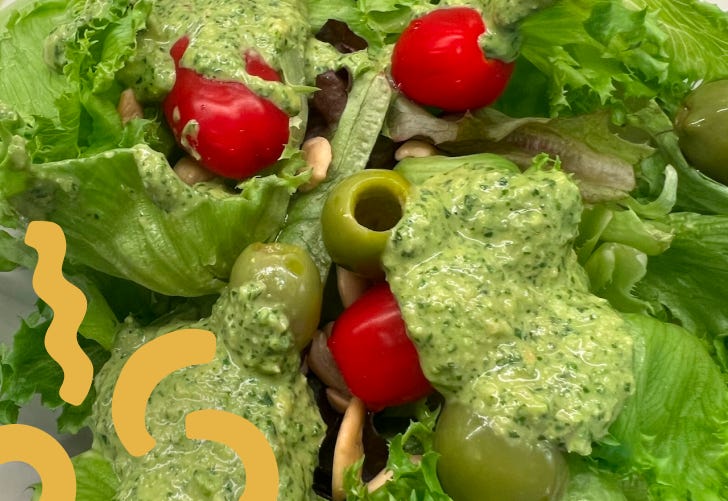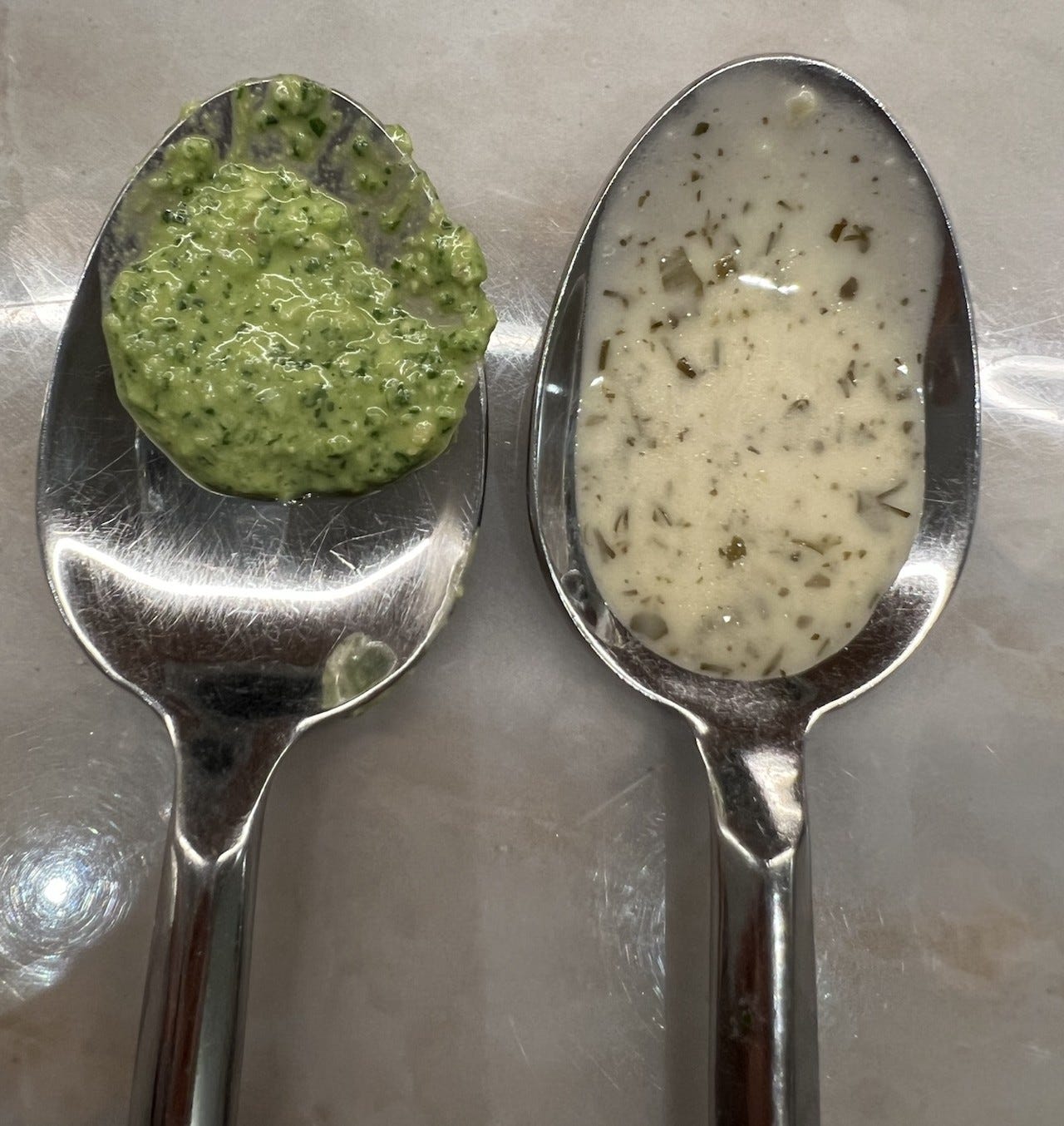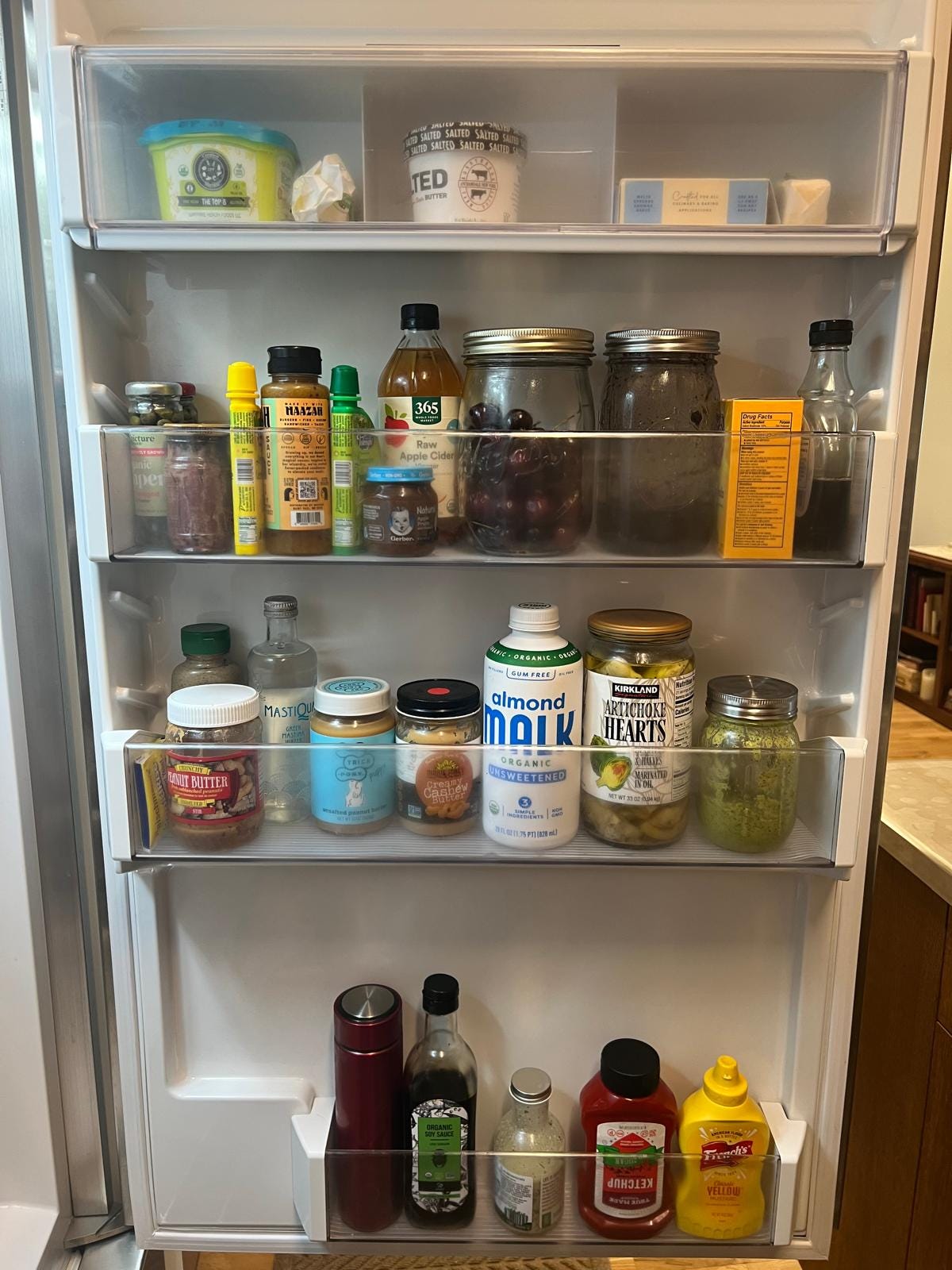The Condiment Challenge 2
Should I keep those store-bought salad dressings?
Ever since I wrote the original Condiment Challenge, I’ve been fixated on the side door of the refrigerator where we keep bottled dressings and other condiments. It’s the spot my eyes continued to be immediately drawn to when I opened the refrigerator door because I still wasn’t certain I had excised all the junk, though I tried mightily.
A couple of salad dressings remained, and I wasn’t entirely convinced they were the best we could do. Phil, meanwhile, was happy that he still had at least two dressings left after clearing out old, expired, or unhealthy condiments.
But the salad dressing issue continued to nag me. Once I started researching this topic for the article, I realized that salad dressings aren’t always the healthiest option to eat. It truly depended on what I picked up in the store and how much we were using of it.
Many, though not all, store-bought dressings have confusing labels, such as “light” or “fat-free,” but upon closer inspection, I sometimes found high-fructose corn syrup hiding inside. Some creamy dressings used mayonnaise, cheese, or sour cream as a base, which, when combined with saturated and trans fats, are not exactly cholesterol-friendly or heart-healthy.
Salt content could be another concern in dressings. Excessive sodium intake can impact your blood pressure and cardiovascular health. Additives and preservatives help extend shelf life and improve texture, but they have been linked to stomach and gut issues.
These concerns should not lead you or me to think all salad dressings should be tossed out. It’s just that it’s not always clear which ones are good. And there are definitely a few good ones to be found.
Still, why was I still buying them so easily? Why do any of us? There are rows and rows of them at the store. When I walked through Whole Foods the other day, I saw how easy it would be just to grab one.
The truth is people like salad dressings. Phil likes some of them, even though I’m not a fan. They’re convenient, they’re always in the kitchen, they’re familiar, and what you don’t know won’t hurt you at least not right away. And the marketing, including the packaging and the buzzwords, is so appealing that it just feels like it must be okay.
What to do if you have dressings
Again, I'm not saying all salad dressings are bad, but you need to look carefully at them, and that’s a big part of what the Fischer Kitchen is about. I’m paying more attention these days, and I encourage you to do the same. You don’t have to obsess, but you do need to care. It’s a small step, and it’s worth taking.
So, if you have salad dressings in your fridge, here’s what I think:
If you think it’s good, still be careful about how much you actually use. More often than not, Phil pours the dressing and ends up with a quarter of the bottle on his plate. At that point, why bother eating the salad? “It’s totally wrecked,” I said. I urged him to try a tablespoon instead because it’s easier to control. Now he takes that route.
If you’re unsure it’s good, check the side of the bottle and read the ingredients. The nutrition label is one of the best tools we have as consumers. It gives us at least some idea of what’s really inside. We should care about this for ourselves, for the people we love, and for those we want to be around for a long time.
If you have a favorite you’ll never give up, no matter what’s in it, then just aim for some balance and moderation. Use a tablespoon to measure! But again, that part’s truly up to you.
Time to pivot
And finally consider making dressings yourself. I never used to, but now that we’re running low on the last store-bought salad dressing, I don’t plan to buy more unless it’s necessary. We can manage just fine with oil and vinegar, as well as a few homemade experiments.
My latest inspiration came from an unexpected source. In a previous post, I mentioned attending the Women in Hospitality conference at Google’s New York headquarters, where every attendee received a copy of Come Hungry: Salads, Meals, and Sweets for People Who Live to Eat by Melissa Ben-Ishay. She’s the CEO of Baked by Melissa, and although I’ve never tried one of her tiny cupcakes (I don’t eat sweets often, though you will find me nip off a corner for a taste), I’ve passed her store countless times in Lower Manhattan.
Melissa Ben-Ishay (seated left) being interviewed by Anna Mandelbaum, S. Pellegrino Gastronomy Partnerships, National Manager
But her cookbook, my goodness, I love it. Everything looks healthy, real, and easy to prepare. She even has a whole section on dressings and vinaigrettes. With a bit of help from the computer, they were evaluated and ranked based on calories, fat, sugar, and sodium, each receiving a custom score.
Each dressing also got a dietary focus name: Low Sodium Hero, Sugar-Free Only, General or Keto-Friendly. Finally, there was a column noting the keys to the dietary focus. I don’t expect everyone to do this, but I think you can see how far down the rabbit hole I went. As that’s because as we age, I genuinely believe we need to pay even more attention to what we choose to eat.
It doesn’t mean you can’t enjoy something sweet now and then. It doesn’t mean you have to give up a favorite recipe that includes sugar, salt, or fat. But it does mean being mindful of how much you eat. You’ll know what’s best for you.
Once the recipes were scored, I handed the spreadsheet to Phil. First up: Green Goddess: 33.8 calories, 3.3 g fat, no sugar, 130.8 mg sodium. It’s a vinaigrette. The custom score, our balance of calories, fat, sugar, and sodium? 40.67.
It’s officially 'low-sodium' by FDA standards—that would be 140 mg or less per serving, so it earned our title of a Low-Sodium Hero. It also scored highly for heart health and anti-bloat benefits.
We followed the recipe, adding basil, spinach, cloves, shallots, extra virgin olive oil, nuts (we used unsalted cashews), nutritional yeast, sea salt, rice vinegar, chives, and lemons. We slightly messed up on the lemon. The recipe called for the juice of two lemons. Phil squeezed those, and without double-checking, I poured them into the food processor. In parentheses, it said next to two lemons: (about 1/3 cup).
“We put in too much lemon,” I said.
“Don’t worry about it. We got the rest of the ingredients right. Even if it tastes a bit lemony, I’ll be okay with it,” Phil said.
A taste test confirmed we had indeed made a good Green Goddess dressing, despite using too much lemon. I compared it to a store-bought version of Green Goddess dressing.
Our version was robust and flavorful; the store-bought one was thinner and had more tang than our homemade version, even with the extra lemon.
Try you own dressing challenge
You might enjoy doing your own dressing challenge at home. Many store-bought options can be replaced by good recipes like the one I made. That way, you can avoid ultra-processed ingredients, refined oils, added sugars and sodium, and the saturated fats that show up in creamy varieties, not to mention artificial additives and preservatives.
If you make it yourself, you also skip all the marketing on the front of the bottle. Terms like “organic,” “fat-free,” “healthy” sound great but might be misleading, depending on the actual ingredients. Flip it over and you might find sugar, artificial sweeteners, and seed oils that may not align with your goals, depending on what matters to you.
I completely understand if my fixation on salad dressings sounds extreme. The ones at the store are tasty, convenient, and they last a long time. I won’t deny that.
But if you’re going to buy one, I’d suggest stopping for a moment, turning the bottle around, and reading the label. Choose the best brands you can find, many of which can include extra virgin olive oil, avocado oil, or yogurt-based options. These are generally better bets than the sugary and fatty-loaded kinds.
Since this is a complex topic, I wanted to share a link for you to check out as you form your own opinion. I’d love to hear your perspective. Take a minute to answer the poll and let me know!
Oh, and Phil? He’s going to be just fine with homemade dressing because that’s what he’s got. He’s quickly warming up to the new normal, replacing regular dressings with homemade salad dressing each week, because it tastes fresher than store-bought ones.
“Using the right dressing or no dressing might only have a marginal effect on lifespan or it might not. But it’s a commitment to the larger goal of health and healthspan,” he said.
That’s the spirit!
Heading toward the big “30” in a few years (only kidding, he’s got more than a few years on that, me too!), he’s right. We’re aiming for 100, one homemade dressing at a time with a thinned out selection on the side of the refrigerator door.








I enjoyed reading this, Linda. Well done!
Susan